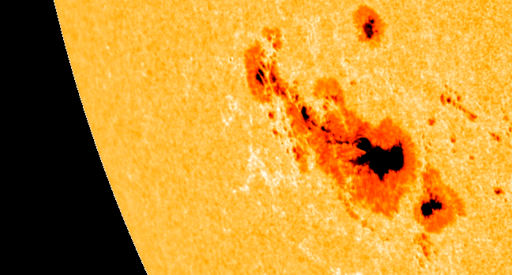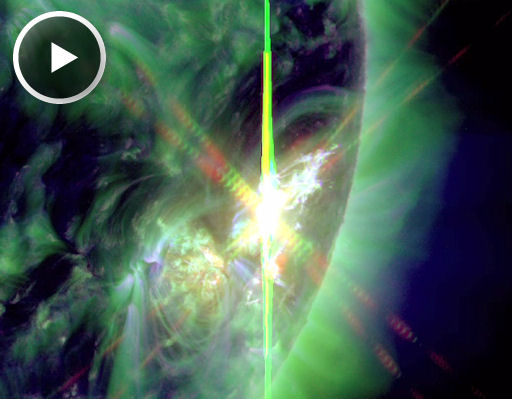Thirty-five new items have just been added to our Meteorite Jewelry collection. Browse the Space Weather Store for something out of this world. | | | MORNING SKY SHOW: Jupiter and Venus are converging in the morning sky for a beautiful conjunction that appears in the east just before sunrise. Check the realtime photo gallery for snapshots from around the world--and set your alarm for dawn. ANOTHER BIG SUNSPOT: As one big sunspot (AR1515) turns away from Earth, another one is turning toward our planet. AR1520, now emerging over the sun's southeastern limb, stretches more than 127,000 km (10 Earth diameters) from end to end: 
AR1520 has a 'beta-gamma' magnetic field that harbors energy for M-class solar flares. So far, however, the sunspot's magnetic canopy is crackling with lesser C-flares. The calm before the storm? NOAA forecasters estimate an 80% chance of M-flares during the next 24 hours. X-flare alerts: text, voice. Realtime Space Weather Photo Gallery X-FLARE: For days, giant sunspot AR1515 has looked capable of producing a really strong explosion. On July 6th it finally did: The sunspot's magnetic canopy erupted, producing a brief but potent X1.1-class solar flare. NASA's Solar Dynamics Observatory recorded the extreme ultraviolet flash: 
The explosion hurled a CME into space. According to this movie from the Solar and Heliospheric Observatory, the cloud appears to be heading south and away from Earth. Update: Analysts at the Goddard Space Weather Lab say the CME will miss eveything. Their forecast track shows the cloud not hitting any spacecraft or planets. Look at the CME movie one more time. The speckles near the end are caused by energetic protons accelerated by the flare. Guided toward Earth by solar magnetic fields, the protons are peppering Earth-orbiting satellites, causing "snow" in imaging systems and posing a slim threat for single-event upsets (computer glitches).
Realtime Noctilucent Cloud Photo Gallery
[previous years: 2003, 2004, 2005, 2006, 2007, 2008, 2009, 2011] Potentially Hazardous Asteroids ( PHAs) are space rocks larger than approximately 100m that can come closer to Earth than 0.05 AU. None of the known PHAs is on a collision course with our planet, although astronomers are finding new ones all the time. On July 8, 2012 there were potentially hazardous asteroids. Recent & Upcoming Earth-asteroid encounters: | Asteroid | Date(UT) | Miss Distance | Mag. | Size | | 2012 MY2 | Jun 29 | 1.3 LD | -- | 24 m | | 2003 KU2 | Jul 15 | 40.2 LD | -- | 1.3 km | | 2004 EW9 | Jul 16 | 46.8 LD | -- | 2.1 km | | 2002 AM31 | Jul 22 | 13.7 LD | -- | 1.0 km | | 37655 Illapa | Aug 12 | 37 LD | -- | 1.2 km | | 2000 ET70 | Aug 21 | 58.5 LD | -- | 1.1 km | | 1998 TU3 | Aug 25 | 49.2 LD | -- | 4.9 km | | 2009 AV | Aug 26 | 62.8 LD | -- | 1.1 km | | 1998 UO1 | Oct 4 | 60.1 LD | -- | 2.1 km | Notes: LD means "Lunar Distance." 1 LD = 384,401 km, the distance between Earth and the Moon. 1 LD also equals 0.00256 AU. MAG is the visual magnitude of the asteroid on the date of closest approach. | | The official U.S. government space weather bureau | | | The first place to look for information about sundogs, pillars, rainbows and related phenomena. | | | Researchers call it a "Hubble for the sun." SDO is the most advanced solar observatory ever. | | | 3D views of the sun from NASA's Solar and Terrestrial Relations Observatory | | | Realtime and archival images of the Sun from SOHO. | | | from the NOAA Space Environment Center | | | the underlying science of space weather | | 
